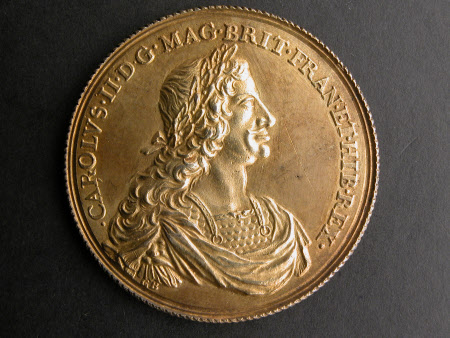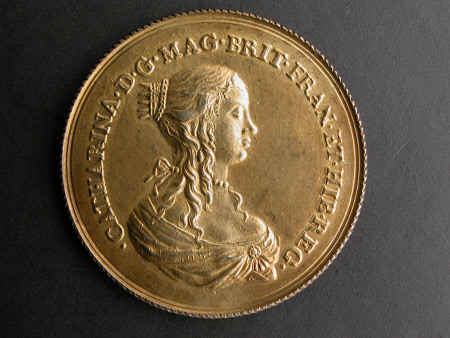Charles II and Catherine of Braganza
George Bowers (fl.1660 - 1689)
Category
Coins and medals
Date
1662
Materials
Silver
Measurements
52 mm (Diameter)
Place of origin
Great Britain
Order this imageCollection
Osterley Park and House, London
NT 773267
Summary
Silver-gilt, medal commemorating the marriage of King Charles II (1630-85) and Catherine of Braganza (1638-1705), by George Bower (fl. 1660-89), United Kingdom, 1662. A commemorative medal designed by George Bower, struck to celebrate the marriage of King Charles II and Catherine of Braganza in 1662. Charles depicted on obverse facing left, hair long and with laurel wreath, wearing scaled armour, lion’s head pauldron at shoulder, and cloak. Latin Legend translates as: Charles II by the Grace of God King of Great Britain, France and Ireland. The artist’s initials G.B. below the shoulder. Reverse depicts Catherine of Braganza, facing right, hair gathered behind and fastened into a small coronet, ringlets descending onto her neck; she wears ear-ring, pearl necklace and a mantle, fastened at front with a brooch. Legend translates as: Catherine by the Grace of God Queen of Great Britain, France and Ireland. Edge beaded.
Full description
On Charles II’s restoration, the need to procure a suitable marriage for the new monarch was a pressing concern from the start. Whilst a number of candidates for marriage were considered, the choice eventually settled on Catherine of Braganza, the daughter of John, 8th Duke of Braganza, later King John IV of Portugal. As part of the marriage settlement, Portugal, engaged in a struggle to maintain her independence from her neighbour Spain, won permission to enlist English troops for her defence, and offered in return an enormous dowry of some £300,000, as well as Tangier in North Africa and Bombay (today’s Mumbai) in India. By opening up the Portuguese trade routes to English merchants, the marriage was an important step in the expansion of English mercantile interests beyond Europe. The treaty for the marriage was signed on 23 June 1661. The medal is one of a number made to commemorate the marriage of Charles with Catherine of Braganza (for others in the collection at Osterley Park, see NT 773265 and 773266). The couple were formally married in Portsmouth, on 21 May 1662, the day after Catherine’s arrival in England. They formally entered London on 30 September 1662. Charles had never seen Catherine before her arrival at Portsmouth; she wore Portuguese costume for their first meeting, which may have prompted the apocryphal comment attributed to the King, that he had been brought a bat rather than a woman. However, when he actually met Catherine, Charles wrote to Lord Clarendon that ‘her face is not so exact as to be called a beauty, though her eyes are excellent good, and not anything in her face that in the least can shock one. On the contrary, she has as much agreeableness in her looks altogether, as ever I saw… if I am skilled in physiognomy, which I think I am, she must be as good a woman as ever was born.’ Unlike the Marriage medals by John Roettiers (NT 773265-66), George Bower has depicted Catherine of Braganza not in the form of a classicising portrait bust, but with a hairstyle and in dress that is closer to contemporary fashion in Britain. Nevertheless, the portrait is still relatively idealising, when compared with Bower’s more realistic medallic image of Catherine Bower made just two years later, in 1664 (Medallic Illustrations, I, pp. 491-92, no. 115; Macleod and Marciari Alexander 2001, p. 87, no. 11). Some examples of the present medal have an inscription on the edge, SIC. SINE. FINE. DVOS. AMBIAT, VNVS. AMOR (‘Thus one endless love shall encircle both’). Coming from the quiet and strictly Catholic court of Portugal, Catherine of Braganza was quite unprepared for what she found in London, especially the King’s many mistresses, among whom Barbara Villiers, Countess of Castlemaine (1640-1709) reigned supreme at the time of Charles’s marriage. In the early days of their marriage, Charles was often cruelly cold to his new bride, obsessed with Barbara Villiers who, between 1661 and 1665, gave birth to five children by the king. Catherine on the other hand suffered several miscarriages but no successful births. It became ever clearer that the queen, whose Catholic faith made her an unpopular figure among her British subjects, would never provide an heir. Despite his many dalliances, the king’s relationship with his wife remained on the whole respectful and, towards the end of his life, increasingly close. Jeremy Warren 2019
Provenance
Given to the National Trust in 1993 by George Child Villiers, 9th Earl of Jersey (1910-1998).
Credit line
National Trust Collections (Osterley Park, The Jersey Collection)
Marks and inscriptions
Obverse, legend: CAROLVS. II. D. G. MAG. BRIT. FRAN. ET. HIB. REX. Artist’s signature : G.B. Reverse, legend: CATHARINA. D. G. MAG. BRIT. FRAN. ET. HIB. REG.
Makers and roles
George Bowers (fl.1660 - 1689), medallist
References
Hawkins, E. (ed.) Franks, A.W. and Grueber, H.A: Medallic Illustrations of the History of Great Britain and Ireland to the death of George II, 2 vols,. London, 1885, vol. I, p. 482, no. 93

